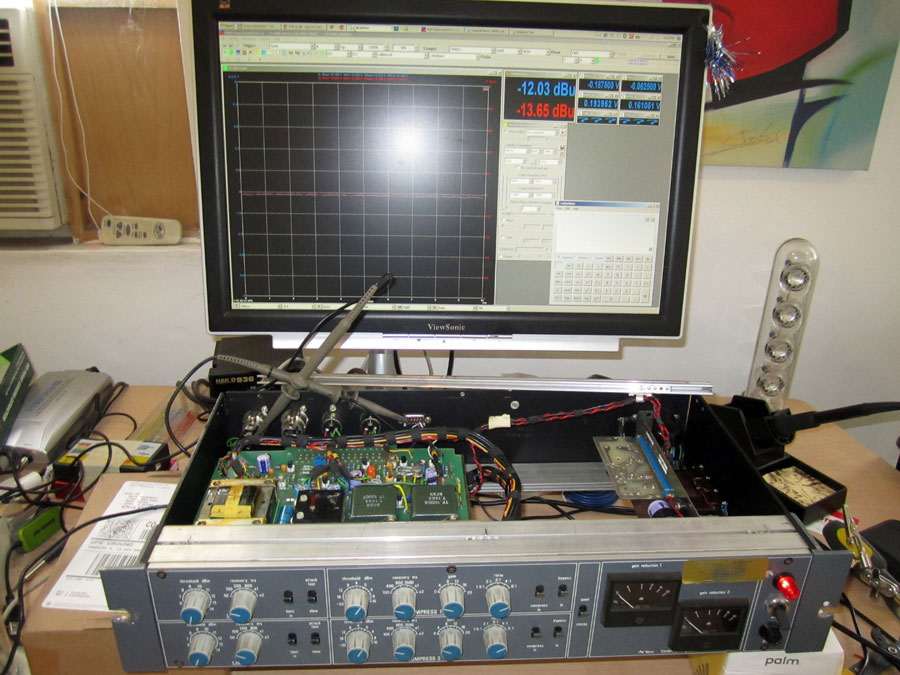Hi All,
This might be an interesting piece of info for all of you who have the unit built or thinking about building one. A few days ago I decided to get an original 33609 (the original version, with Marinair transformers, back from 1988) to settle (literally) once and for all my debate about whether or not the DIY version has the same/similar time constants and frequency response, because they don't sound the same to my (and many others') ears. This time (as opposed to back in 2008, where I only did listening comparisons between the two - see pages 19-21-ish...) I actually had the tools to measure the attack/recovery behavior, as well as to sweep the units and do some THD/SNR tests. Here is what I found out:
The compressor recovery time constants are nearly identical between the units, but the attack on the original is noticeably slower (which I could identify by listening to both units, not just measuring) - 25ms, vs DIY's 15ms. I modified one of my DIY units with replacing R31 with 1k1, which brought it to about 22ms. I suspect somewhere around 1k2 or 1k3 there would make it closer to original's attack response. There is virtually NO info on the internet about 33609's compressor attack time. The only page I found had 40ms listed... which seemed a bit too long.
I also modified the compressor recovery settings to bring them closer to the label values on the front panel. Initially both the original and DIY had 70ms measured recovery @ 100ms switch position, 285ms @ 400ms, 600ms @ 800ms, etc... I replaced 24k with 33k, which made the 100ms position exactly 100ms, and 75k with 100k, which made the 400ms position exactly 400ms. It, of course, shifted the rest of the recovery settings to release slower (850ms and 1800ms) which I really like.
Now the limiter section is where things got hairy... My DIY unit measured exactly 2ms on fast attack settings and 4ms on slow attack - 100% dead on within specs. The recovery times were exact too - 55, 120, 240, 1000, 2300, 6000 at each switch setting. The original measured waaaay slower - attack times were doubled (??) - 4ms on fast, 8ms on slow. The recovery times were noticeably slower as well - 80, 165, 330, 1300, 3350, >7sec. Does that mean it needs a recap? =) I'm not sure, but I'm sure that was the reason for limiter to behave a lot smoother in my listening tests on the same settings as the grainy distorted DIY version.
So, the above info revealed to me that overall the DIY unit measured closer to Neve specs, but how does it SOUND? =) I'm yet to acquire a definitive conclusion on that topic after I run it through some listening tests in the next couple of weeks and maybe take it to big commercial studios to be checked out in that setting.
The thing that still bugs me a bit about the DIY version is its inability to calibrate the meters exactly. The original has it pretty dead on in 0-20dB range, while the best thing for the DIY version is to calibrate it exactly at 8dB reduction. Then it drifts upwards when applying more reduction (i.e. 12dB CV will show as 13-14dB on the meter) and downwards with less deduction (i.e. 4dB CV will show 2-3dB on the meter). Any solutions to that?
Thanks for reading! =)













![Soldering Iron Kit, 120W LED Digital Advanced Solder Iron Soldering Gun kit, 110V Welding Tools, Smart Temperature Control [356℉-932℉], Extra 5pcs Tips, Auto Sleep, Temp Calibration, Orange](https://m.media-amazon.com/images/I/51sFKu9SdeL._SL500_.jpg)





















